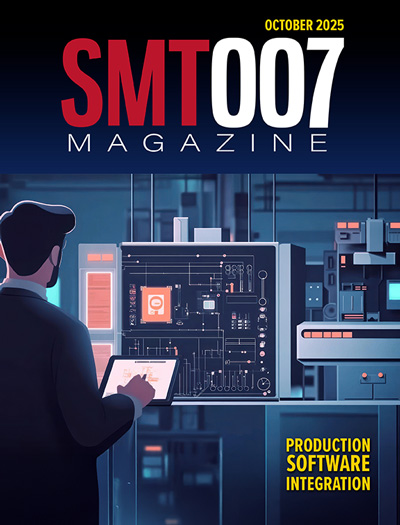-

- News
- Books
Featured Books
- smt007 Magazine
Latest Issues
Current Issue
Production Software Integration
EMS companies need advanced software systems to thrive and compete. But these systems require significant effort to integrate and deploy. What is the reality, and how can we make it easier for everyone?

Spotlight on India
We invite you on a virtual tour of India’s thriving ecosystem, guided by the Global Electronics Association’s India office staff, who share their insights into the region’s growth and opportunities.

Supply Chain Strategies
A successful brand is built on strong customer relationships—anchored by a well-orchestrated supply chain at its core. This month, we look at how managing your supply chain directly influences customer perception.
- Articles
- Columns
- Links
- Media kit
||| MENU - smt007 Magazine
Estimated reading time: 3 minutes
Proper Thermal Shielding Yields Highest Rework Results
There are numerous "gotchas" if the rework technician does not care for components and materials neighboring the component rework area. If this care is not taken, the rework component might have been properly reworked, but the PWB itself may not be functional due to thermal damage. While PCB rework processes using best-in-class methods, materials, and equipment may have a high yield, an even higher yield can be achieved by protecting surrounding components.
Figure 1: Skewed component due to proximity to the one being reworked and improper shielding.
During component rework, taking extreme care of nearby components—whether they are adjacent to the device being reworked or on the opposite side of the board—is required to avoid collateral heat damage, inadvertent reflow, and altered characteristics, such as discoloration or part skewing. Damage can be done to the part physically when the heat from the rework source is beyond the range of what the component is rated. This is common with connectors, relays, and batteries. In addition to component damage, de-wetting, pad damage, starved solder fillets, and component surface finish oxidation can result.
In some cases, the damage is unseen in the form of increased intermetallic growth in the solder joint, which may impact the reliability of the assembly. In end-use environments where reliability is critical, this increased reliability risk must be investigated for its impact. Also, a process capability study might have to be completed to verify the rework process.
Further, there can be other materials damaged on the assembly that are part of the proper operation and design for its end-use operating environment. These materials can include, but are not be limited to, the following items:
• Underfill materials underneath the components
• Staking materials on the PCB
• Insulative coating materials
• Conformal coatings
• Thermal grease
These materials can dry up, become nonfunctional, soften, or migrate to other areas of the assembly, which all have a detrimental effect. For example, underfill materials have a softening temperature below that of the reflow temperature of the solder. When an underfilled device reaches this temperature, it pushes out solder that reaches reflow temperature and causes shorts underneath the neighboring device. Thus, it is important to know the materials on the board and be aware of technical information on the datasheet from the material supplier or have experience about the materials’ properties.
There are numerous steps the rework technician can take to avoid these neighboring reflow "gotchas." One of the first steps to prevent having to scrap a board or perform rework a second time (if allowed by the customer) is to investigate the materials and components on the board before starting the rework operation. It is better to take a moment to question the material composition of nearby components and pull a few component or material datasheets then to start again.
Figure 2: Use shielding materials, like gel, to mitigate the effects of heat in the rework area.
After the risk areas are identified, protect at-risk parts by either removing or shielding them. The use of ceramic non-woven tape, a metal shield, or shield gel has been shown to be the most effective thermal shields [1]. Finally, placement of thermocouples around the component being reworked when performing rework profiling will help identify issues. If a hot-air or an infra-red (IR) reflow source is used, this will help to pinpoint potential problem areas instead of guessing.
The reflow of surrounding devices in the rework area is a yield detractor in PCB rework. If you are not careful with the reflow source being used, nearby materials may be destroyed or cause the PWB not to meet the initial specifications or design of the assembly. However, careful planning, shielding, and sometimes removing neighboring device or material will ensure the highest possible rework yield.
References
1. Shielding Effectiveness of Polyimide Tape During Rework by Gaynor Adam and Robert Wettermann, Circuits Assembly, October 2014.
More Columns from Knocking Down the Bone Pile
Knocking Down the Bone Pile: Revamp Your Components with BGA ReballingKnocking Down the Bone Pile: Best Practices for Electronic Component Salvaging
Knocking Down the Bone Pile: Addressing End-of-life Component Solderability Issues, Part 4
Knocking Down the Bone Pile: Tin Whisker Mitigation in Aerospace Applications, Part 3
Knocking Down the Bone Pile: Gold Mitigation for Class 2 Electronics
Knocking Down the Bone Pile: Basics of Component Lead Tinning
Knocking Down the Bone Pile: Package on Package Rework—Skill Required
Knocking Down the Bone Pile: 2023’s Top Challenges in BGA Rework


